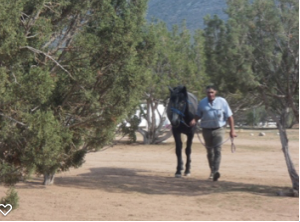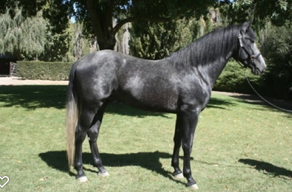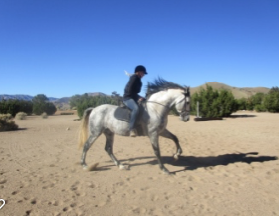PURPOSE OF THIS ARTICLE
Understanding dressage is first and foremost about understanding its principles or the theory and knowledge which guides the training of the horse. It is this understanding which can be applied across the board regardless of one’s riding discipline.
The sad fact of the matter is that if one Googles “dressage principles,” you will come up with nothing. We still have them, but they have been subsumed within the context of tests and performance. I am after the principles which make a good riding horse. That is the goal which drove the great masters and which formed the basis of dressage training historically.
SOURCES TO CONSULT FOR UNDERSTANDING DRESSAGE
Dressage theory and method grew out of preparation of horse and rider for mounted combat. Both had to be exquisitely prepared or lose their lives. For me this must be an excellent theory and method indeed.So where might the modern rider who seeks excellence in his/her horsemanship find the principles I’m talking about? The Spanish Riding School of Vienna is our modern keeper of dressage truths which have been historically developed. Unfortunately, they are not written down but have been passed down by word of mouth. For something written, one could look to Holbein’s Directives, 1898. Holbein presents a line of thought for maintaining a methodical system while training one’s horse. He, in turn, compliments other historical horsemen, not the least of which is La Gueriniere, 1751.
WHERE I INTEND TO LOOK TO UNDERSTAND DRESSAGE AND ITS PRINCIPLES
But I am a horsewoman, a dressage rider who wants to undertake systematic study of what I do and why I do it in the present. Where do I look without having to undertake rigorous historical research? For starters, I will consult my memory. That is what I will do in this article.
Following that, I will be examining the work of a contemporary horse master of dressage, Alois Podhajsky. Podhajsky has written what is considered by many to be the foundation work on dressage theory and practice Complete Training of Horse and Rider in the Principles of Classical Horsemanship. Note the word “classical” in the title of Podhajsky’s book. It is my intent throughout this website to cling to classical principles, that is, the principles horse masters throughout the centuries have found to be essential to the basic training of the horse for riding.
I will then consult the modern dressage training scale used to prepare horses for dressage competitions both in the United States and abroad. The idea here is to see how closely the training scale aligns with classical principles set out by Podhajsky. I will also refer to Frenchman Philippe Karl and German Gerd Heuschmann for their recommendations on how to improve the training scale. This will all be in separate articles. Finally, I will try to put everything together in some kind of unified pathway which at least I find useful. That’s a beginning.
HOW/WHERE I LEARNED ABOUT DRESSAGE PRINCIPLES
I was taught dressage as a little girl by two Germans. I quit riding for many years and took it up again later in life through the sport of endurance racing. It was during this time that I called forth my dressage training once again and had the privilege of drawing from the teaching of Hungarian Charles DeKunffy. I didn’t have a dressage ring to work in and more often than not found myself practicing out on the trail, finding big bushes around which to practice circles and wishing I could do seamless flying changes to bring my time down in an endurance race. I went on to ride competitively in dressage and worked under a variety of coaches, not the least of whom was beloved Colombian Ricardo Amaya and Canadian David Johnston.
What stays with me from all this experience is my quest for harmony with my horse. “Harmony” as defined in the Cambridge English Dictionary is “A situation in which people (or creatures) are peaceful together with each other or when things seem right or suitable together.” I have been on a quest for a harmonious relationship with my horse and on a journey to find the best way to do that throughout my life. Dressage for me has always been a vehicle to do this. But I must then ask what are the things which I’m communicating so that my horse and I might work harmoniously together. I’m going to name these things or principles below as I remember them. How one achieves them, I will leave for a later discussion.
A FEW DRESSAGE PRINCIPLES AS I REMEMBER THEM; What We Strive For When Training Good Riding Horses and Developing Harmony with Them.
A Forward Horse
“Forward” is an attitude of the mind. The horse must be inspired to move willingly forward. There must be the feeling of the horse taking the rider someplace with energy. One cannot do anything on a horse without this. In a sense, it is why we ride, to be carried along by this powerful creature so much stronger than ourselves and faster than we could go. “Forward” entails a certain responsiveness to requests from the rider. A horse can be forward in the halt; that is, he is forward thinking and ready to launch ahead when asked by the rider. He could also and should be forward when backing up; that is, he backs up easily, energetically ready to launch straight ahead.
A Straight Horse
A straight horse is a horse whose body is in alignment; that is, his hind feet track into the line of the front feet regardless of whether or not he is turning or moving straight ahead. A straight horse is thus not ruler straight but maintains this alignment on arcs and curves because he is properly bent to conform to the geometry he is pursuing. Straightness enables forward because the impulsive power of the hind legs, the horse’s engine, is most available when the hind legs follow the front, not escaping from one side to the other.

A Straight Horse.
When Sea Biscuit raced War Admiral in the greatest match race of all time in the 30’s, it could be argued that the most critical part of the race was the start, the take-off. There was no starting gate. Both stallions had to be trained to take off dead straight when the gun went off so that the massive push of their hind legs could thrust their bodies equally forward on the track. Hind legs escaping to the left or right during this moment would have meant losing costly milliseconds of power in a contest of equals in which no mistakes could be made. It will be remembered that Sea Biscuit won this race.
Horses tend to be born with a tendency to be crooked; that is, they tend to be “right-” or “left-handed.” A right-handed horse who is more pliable on the right side but stiff on the left will tend to throw his haunches in to the right. A dressage training method can be used to correct this by making the horse more supple on both sides.
Now, we have come to a core principle of dressage training, as I remember it:STRAIGHTEN YOUR HORSE AND RIDE HIM FORWARD.
A Balanced Horse
A horse carries more of his weight on the forehand where the head and neck are located. This works out just fine for a horse who does not carry the extra weight of a human rider. Once he is mounted by a human, however, things change for him. He can become unbalanced if the rider does not endeavor to show him that equilibrium is better attained if he is able to shift more of his weight towards the hind quarters thus, at least, better equalizing the weight carried by both the front end of the horse and the hindquarters. This is one of the goals of dressage training, to help him do that.
A horse’s conformation is involved here as well. In general, a good riding horse will appear to have a more “up hill” tendency’ that is, when viewed from the side, he will appear balanced with weight more evenly distributed between the front and back of the horse. Put in another way, the tip of the wither and the croup will be approximately on the same plane with the wither just slightly higher than the croup.

Reasonable Balance for 2-Year Old Andalusian Stallion. He will Mature
A rider, furthermore, assists balance by sitting over the horse’s center of gravity.This center of gravity is behind the horse’s wither where the rider is generally perched in a good riding saddle but will shift depending on what the horse is doing. The rider, in turn, must accomodate this shift.
Riding a horse in balance gives one the feeling that s/he is sitting at least perpendicular to the ground moving silghtly uphill and not being thrown forward or back.
Contact with Your Horse
A rider makes contact with the horse with his seat, legs, weight, and hands – – all these things. Typically, however, when we speak of contact, we tend to refer to the feel of the rider’s hands with the horse’s mouth. Good steady contact means that the horse has an even feel in one’s hands; he does not pull the rider forward in which case he would be heavy in the hand, nor does he avoid contact with the rider’s hands as when he carries his head too high or is “above the bit.”
Good, steady contact means one’s horse is “on the bit.” A horse that is on the bit is talking to your hands with an alive and supple mouth. A spectator might even observe some froth framing the horse’s mouth as he moves his tongue and lips around the bit, conversing with the rider’s hands.
Educated hands are crucial in enabling contact and communication between the horse and the rider.

Good Contact Between the Rider’s Hand and the Horse’s Mouth
A Collected Horse
Collection is an advanced dressage concept and indeed could be said to be one of its main goals. Collection is that state in which the hind legs are engaged beneath the horse and the croup is lowered to enable those wonderful advanced movements like a collected canter, piaffe, passage, pirouettes. The horse is above all light in the hand yet there is still contact.
My favorite image of collection is my wonderful endurance race horse CF Drumsong (Aspen) galloping up a hill then collecting himself at the top to canter down the other side so slowly that a person could literally walk right along side us. To achieve such a canter and then be ready to bound up the other side again would mean that Aspen was in extreme collection, his weight well back on his hind legs to balance the canter down a hill.
Below is a picture of my young stallion Soñador pursuing a small hill in hand in a collected frame.

Collected Frame. And the geography is helping by sending the stallion up a little hill. I’m hanging on.
WHAT WE HAVE LEARNED
So far, there are about five principles that I have recovered from my memory. This constitutes the theory that a classical rider strives for when working with his/her horse regardless of discipline. They are the goals the rider strives for in communicating with his/her horse to develop harmony with him and include the following:
- forward
- straight
- balance
- contact
- collection
The Theory Put Together in a Classical Riding Performance
My most vivid memory of harmonious communication between horse and rider is of the Spanish P.R.E. stallion Fuego and his rider during their performance at the 2008 World Equestrian Games. This communication expressed itself in seamless transitions which brought together the five principles I named above. Fuego would move from passage to regular trot to extended trot with a fluidity I can scarce remember from any other performance. It was beautiful and relaxing to watch. Since it is the rider who requests these transitions and must communicate the requests clearly to the horse, the overall impression is a horse and rider in perfect harmony.
This is pure joy. How lovely and comfortable it is to experience this flow from rider to horse and from horse to rider. You don’t need a performance to achieve this, but it is a performance where we the public can participate in and enjoy this relationship between horse and rider.
I have been lucky enough to have achieved this feeling on my horses at different times and under different circumstances. It is as if you think your request, and the horse understands and complies.
CALL TO ACTION
Please comment on this article. If you can, tell us about experiences of harmony with your horse and how the principles of dressage enumerated above helped you get there.
I have realized after going back and reading my article that “transitions” are not really a training principle so much as they are a training exercise. I use them a lot with my P.R.E. stallion Soñador to help his reponsiveness and attention to my leg. Also, there is a incredibly important principle missing from my list which is “relaxation.” Without relaxation, everything else one does with her horse becomes that much more difficult. I will discuss this further in future articles. Carole